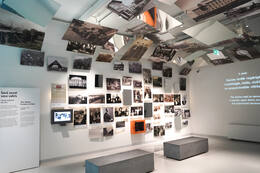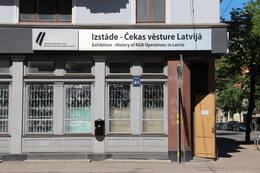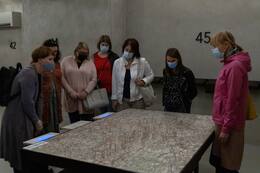Nõukogude-vastane agitatsioon ja propaganda
IV Nõukogude okupatsioon
"Nõukogudevastane agitatsioon ja propaganda" - väga ideoloogiline termin, mis on NSV Liidu kriminaalõigusesse sisse viidud alates 1920. aastatest ja oli poliitilistes vaidlustes üks sagedamini kasutatavaid seaduseartikleid. NSV Liidu 1926. aasta kriminaalkoodeksis oli vastutus Ö nõukogudevastase agitatsiooni ja propaganda Õ eest sätestatud artiklis 58.
Pärast Läti okupeerimist, novembris 1940, kehtestati see kriminaalkoodeks tagasiulatuvalt ka Lätis. 1961. aastal võeti vastu ja jõustus Läti NSV kriminaalkoodeks, mille artiklis 65 oli ette nähtud vastutus "nõukogudevastase agitatsiooni ja propaganda eest". Selles artiklis sätestatud karistus nägi ette Ö kuue kuu kuni seitsme aasta pikkuse vangistuse Õ ja kahe- kuni viieaastase vangistuse. Teisest küljest nägi artikli 65 teine lõige ette, et isikuid, kes on juba eriti rasketes avalikes kuritegudes süüdi mõistetud, karistatakse kuni kolme- kuni kümneaastase "vangistusega" ja kahe- kuni viieaastase vangistusega.
Läti riigiarhiivis on viimased KGB uuritud poliitilised kriminaalasjad Kriminaalasjade Fondis 1986. aastast. Palju dokumente 1980-1990. 19. sajandi vahetusel õnnestus KGB-l Venemaale eksportida või hävitada.
Rohkem teabeallikaid
Poliitilised kohtuvaidlused okupeeritud Lätis 1983. aastal. Virtuaalne näitus. Läti Rahvusarhiiv, 2013. http://www.archiv.org.lv/1983/index.php?id=303
Gints Zelmenis, Bruno Javoišs, Ivo Grundulis. Rahvuslik vastupanuliikumine Lätis 1959–1986. Riia, 2019.
Jānis Ķeruss: Tšehhi vastuseis nõukogudevastasele propagandale ja agitatsioonile. 1957 analüüs. https://www.lu.lv/vdkkomisija/zinas/t/23701/
Māra Miķelsone. Ajaloolane Zelmenis: totalitaarne režiim oli tundlik isegi sümboolsete tegude suhtes. Ir., 16. september 2019. https://ir.lv/2019/09/16/vesturnieks-zelmenis-totalitarais-rezims-bija-jutigs-pret-simboliskam-akcijam/
Seotud objektid
Läti Okupatsiooni-muuseum
Muuseumis eksponeeritakse Läti ajalugu Natsi-Saksamaa ja Nõukogude Liidu okupatsiooni ajal aastatel 1940–1991. „Tuleviku maja“ on okupatsioonimuuseumi rekonstrueerimis- ja laienemisprojekt, mille autor on Ameerikas elav tuntud läti arhitekt Gunārs Birkerts, ning sellega seotud uus muuseumiekspositsioon. Okupatsioonimuuseumi väljapanek „KGB ajalugu Lätis“ asub KGB-hoones (Nurgamajas). Läti Okupatsioonimuuseum asutati 1993. aastal. See jutustab pikka aega varjatud loo Läti riigi, rahva ja maa saatusest kahe võõrriigi totalitaarse okupatsioonivõimu all aastatel 1940–1991. 2020. aasta lõpus kuulus muuseumikogusse üle 70 000 ajaloolise eseme (dokumendid, fotod, kirjalikud, suulised ja materiaalsed tõendid, esemed ja mälestusesemed). Muuseumi spetsialistid on salvestanud rohkem kui 2400 videomälestust, mis teeb sellest ühe suurima okupatsiooni käsitleva kogu Euroopas. Lätis, Leedus ja Eestis toimunud sündmused näitavad meile selgelt, mida need rahvad pidid kahe totalitaarse režiimi all kogema.
Näitus KGB hoones „KGB ajalugu Lätis"
Külastajatele on avatud endine KGB ehk NSVLi riigi julgeoleku komitee hoone. KGB-lased vangistasid, kuulasid üle ja mõrvasid siin Läti kodanikke, keda okupatsioonirežiim pidas enda vastasteks. Hoonesse on välja pandud Läti Okupatsioonimuuseumi näitus KGB tegevuse kohta Lätis. Vangikambrites, koridorides, keldris ja sisehoovis korraldatakse ekskursioone. 1911. aastal ehitatud maja on üks Riia kaunemaid hooneid. Rahva seas kutsuti hoonet Nurgamajaks ja see oli Nõukogude okupatsioonirežiimi kõige hirmsam sümbol Lätis, üks NSVLi võimusambaid. KGB tegutses Nurgamajas 1940–1941 ja uuesti aastatel 1945–1991. Poliitiline tagakiusamine puudutas otseselt kümneid tuhandeid Läti elanikke. Võitlus Nõukogude vaenlaste vastu jätkus ka pärast Teist maailmasõda. KGB tegutsemisviis muutus veidi pärast Stalini surma. Füüsiline piinamine asendus psühholoogilise terroriga. Enamik KGB agentidest olid lätlased (52%). Venelased moodustasid suuruselt teise rühma (23,7%). 60,3% agentidest ei olnud kommunistliku partei liikmed. Kõrgharidus oli 26,9% agentidest. Süsteem oli üles ehitatud kohalike elanike kaasamisele, et seeläbi saavutada kontroll ühiskonna üle. Töötajate nimekirjad ja teenistusdokumendid asuvad Venemaal. Need ei ole Läti ametivõimudele ja teadlastele kättesaadavad.
Ajaloonäitus „Põlev südametunnistus”
Ajaloonäitust „Põlev südametunnistus” eksponeeritakse Võnnu (Cēsise) lossiplatsi lähedal. See asub nõukogudeaegses ajutises kinnipidamisasutuses ning tutvustab Läti okupatsiooniaega, tutvustab üllatavaid ja kangelaslikke lugusid sellest, kuidas inimesed režiimile vastupanu osutasid. Hoovi on rajatud mälestussein 643 Võnnu piirkonna elaniku nimega, kes hukkusid Nõukogude repressioonide tõttu, sh 1941. ja 1949. aastal küüditatud, mahalastud või surma mõistetud metsavennad. Näitus tutvustab Läti okupatsiooniaega aastatel 1939–1957. Temaatilised tsitaadid kohalikest ajalehtedest võimaldavad võrrelda kahe okupatsioonirežiimi poliitilist propagandat. Kuus ajutiseks kinnipidamiseks mõeldud kambrit on tänaseni säilinud sellisena, nagu need olid aastatel 1940–1941 ning sõjajärgsetel aastatel. Siin hoiti enne KGB Riia peahoonesse saatmist eeluurimise ja ülekuulamise ajal neid Võnnu piirkonna elanikke, kes olid kinni peetud nõukogudevastase tegevuse tõttu: metsavendi, nende toetajaid, noori, kes levitasid nõukogudevastase sisuga lendlehti ning teisi ”isamaareetureid”. Siin on kõik algupärane: raudustega kambrid, uste sisse ehitatud toiduluugid, puulavatsid, kinnipeetavate käimla, väike köök koos ahjuga, tavapärased nõukogudeaegsed õlivärviga kaetud seinad. 2019. aastal sai väljapanek Läti disaini aastaauhinna konkursil rahvusdisaini kategoorias kolmanda koha.
Seotud lood
Liepāja – erinevate ajaloosündmuste ristteel
Liepāja elanikud olid ühed esimesed Lätis, kes kogesid Teise maailmasõja puhkemist, ja ühed viimased, kelle jaoks sõda lõppes nii sõna otseses kui ka sümboolses mõttes. Teine maailmasõda ja Nõukogude okupatsioon Liepājas lõppes alles 1994. aastal, kui Nõukogude Liidu pärija Venemaa viimased väed lahkusid linnast.







